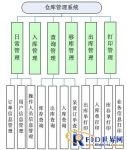
RFID Warehouse Management Information System Solution
[ad_1]
I. Introduction
At present, market competition is becoming increasingly fierce. How to improve production efficiency and reduce operating costs is of utmost importance to enterprises.
Warehousing logistics management is widely used in various industries, designing and establishing a complete set of warehousing management processes, improving warehousing turnover rate, reducing the occupation of operating funds, turning frozen assets into cash, reducing the cost caused by warehousing elimination, and improving the company An important part of production efficiency.
Warehouse management systems usually use barcode labels or manual warehouse management documents. These management methods have obvious disadvantages:
Barcode management: easy to copy, not stain-proof, not moisture-proof, and can only be read at close range
Manual entry: cumbersome work, large amount of data, easy to make mistakes and omissions, increase labor costs in warehousing
The workload of manual inventory is large, which leads to a long inventory cycle, and the missing or stolen goods cannot be found in time
The introduction of RFID radio frequency technology has made enterprise warehouse management transparent and more efficient. Encapsulate the electronic label in a bar code label, stick it on the package or pallet of each goods, and write the specific information and storage location of the goods in the label. At the same time, the detailed information of the delivery party can be written when the goods enter and leave the warehouse, and fixed or hand-held readers are installed in the warehouse and various distribution channels to identify and monitor the flow of goods. The main advantages are:
Labor can be reduced by 20-30%;
99% of warehouse products are visualized, reducing the risk of missing goods;
Improved supply chain management will reduce work service time by 20-25%;
Improve the accuracy and reliability of storage information;
Efficient and accurate data collection provides operational efficiency;
Automatic collection of incoming and outgoing data to reduce human error;
Reduce enterprise warehousing logistics costs.
Today, with the rapid development of logistics automation technology, with the help of RFID fast scanning, barrier-free reading and other features, data collection and processing can be carried out quickly and accurately to achieve standardization and efficient operation of warehouses. Realize quick check and find goods, intuitive storage, scientific and reasonable. Through modern advanced network technology, real-time sharing of warehouse management information such as inbound, outbound, and inventory is realized in the course of enterprise operations. It is convenient for the company to supervise the goods; it is convenient for the warehouse to carry out the storage, outgoing, inventory, and picking of the goods; it is convenient for the company to understand the situation of the company’s goods in the warehouse.
(1) Document scope
1. Comprehensive introduction
2. Functional requirements
3. Non-functional requirements
(2) Document readers
This document is mainly aimed at: project implementers, project managers, developers, testers or document writers.
(3) Explanation of key terms and abbreviations
1. RFID: (Radio Frequency Identification) radio frequency identification;
2. B/S architecture: (Browser/Server) browser/server architecture.
2. Comprehensive introduction
(1) System function introduction

Figure 1 Overall functional framework diagram
The functions of the warehouse management system are shown in the figure above. It mainly includes six functional modules: daily management, warehousing management, query management, shifting management, outgoing management, and printing management.

(2) Analysis of system investment benefits
1. Warehouse entry and exit eliminate the tedious work of scanning one by one, and the speed has been greatly improved.
2. The bar code label on the cargo space is difficult to visualize in the warehouse, and the forklift driver is easy to put the cargo space in the wrong place. The wireless PC and reader on the forklift can ensure that the target cargo position on the shelf is correct.

3. The forklift interacts with the host through a wireless PC, and can grasp the position and status of each forklift in real time. The forklift scheduling can be more flexible and the utilization rate of the forklift can be maximized.
4. The forklift driver receives the warehouse instructions and the shortest path guidance through the wireless PC, which can put the goods on the shelf and pick the goods out of the warehouse faster and more accurately, which can shorten the working time of the forklift driver in the warehouse.
5. When the goods cannot be placed on the target location due to various reasons, the forklift driver can place the goods in other locations, and the real-time accuracy of inventory information can be ensured by reading the location tag association and wireless PC interaction with the host. Avoid the original cumbersome process when the target cargo space cannot be placed, and the inventory is inaccurate due to the busy work of the forklift driver and the failure to record the target cargo space.
6. Major losses that may lead to shipping errors!
7. When the storage of goods is not specified by the system, but the forklift truck determines the storage location of the goods, the real-time storage information can be submitted to the host system through the RFID forklift, which is compared with the manual recording of the traditional scheme and then input into the computer scheme. The real-time and accuracy of inventory have been greatly improved, and the efficiency has also been greatly improved. In traditional warehouse inventory, each box of goods needs to be scanned at close range.
The use of RFID technology will greatly simplify the above procedures. The results of the inventory can be transmitted to the system through the wireless network for recording, eliminating the need for manual entry.
(3) Division of roles and functions
[ad_2]



